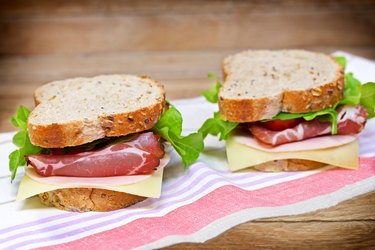
Whether used as the base for a sandwich with crunchy greens, grilled chicken and avocado or spread with nut butter and 100 percent fruit preserves, whole-grain bread is a real palate pleaser. It's also a nutritious part of a healthy diet that can aid in weight control and in the prevention of conditions like heart disease. This is because it retains more nutrients, including fiber, than its refined-grain counterpart. Although they both turn to sugar during digestion, the rate at which they do so makes all the difference.
Carbohydrate Basics
Video of the Day
Carbohydrates are one of the three types of macronutrients, or nutrients your body needs in large amounts, which provide energy in the form of calories to your body. There are three types of carbs -- starch, sugar and fiber. During digestion, your body turns sugar and starch into glucose, your body's preferred source of energy. Fiber remains undigested as it travels through your body, but it tempers the effect of other carbs on your blood sugar.
Video of the Day
Slow vs. Fast Carbs
Carb-containing foods, such as bread, can be classified in two general groups based on how quickly your body processes them and turns them into sugar. Fast carbs, like processed baked goods and white bread, have very little fiber and a lot of sugar, in many cases. Your body doesn't have to do much to break those foods down and they provide a quick source of energy. Slow carbs, on the other hand, are foods like fiber-rich vegetables and whole-grain breads, which your body has to work harder to break down. It takes longer for your body to turn them to sugar, so you get a steadier supply of energy.
The Glycemic Index
The glycemic index is another way to classify foods based on how quickly or slowly they break down and what effect that has on your blood sugar. A carb-containing food that breaks down quickly tends to spike your blood sugar -- which can be good in some cases if you need quick energy, such as during a race. These foods are high on the glycemic index. A low-glycemic-index food will have much less of an impact on your blood sugar, raising it gently and keeping it raised over a longer period of time. One hundred percent whole-grain bread has a glycemic index of 51, making it a low-glycemic food. In comparison, white bread has a glycemic index of 73, making it a high-glycemic food.
Benefits of Whole Grains
In most cases, choosing whole-grain bread over refined-grain bread is a much healthier choice. Whole grains retain their nutrients and fiber content and will provide a steadier source of energy. Eating too many refined carbs can lead to weight gain, high triglycerides and widespread inflammation in the body, according to dietitian Joy Bauer. This goes for all types of grain products, not just bread. Next time you're in the grocery store, choose whole-grain pasta and rice instead of the refined variety.